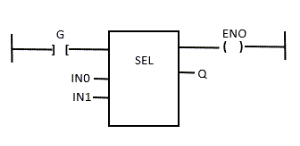
![]() A function calculates a result according to the current value of its inputs. A function has no internal data and is not linked to declared instances. - Select one of the inputs - 2 inputs.
A function calculates a result according to the current value of its inputs. A function has no internal data and is not linked to declared instances. - Select one of the inputs - 2 inputs.
Inputs
|
Inputs |
Data Type |
Description |
|---|---|---|
|
G |
BOOL |
Selection command. |
|
IN0 |
ANY |
First input. |
|
IN1 |
ANY |
Second input. |
Outputs
|
Output |
Data Type |
Description |
|---|---|---|
|
Q |
ANY |
|
Truth Table
| SELECT | Q |
|---|---|
|
0 |
IN0 |
|
1 |
IN1 |
Remarks
- In FFLD language, the selector command is the input rung.
- The output rung keeps the same state as the input rung.
- In IL
 "Instruction list"
This is a low-level language and resembles assembly language, the first parameter (selector) must be loaded in the current result before calling the function.
"Instruction list"
This is a low-level language and resembles assembly language, the first parameter (selector) must be loaded in the current result before calling the function. - Other inputs are operands of the function separated by comas.
ST Language
Q := SEL (G, IN0, IN1);
FBD Language
FFLD Language
(* the input rung is the selector *)
(* ENO has the same value as SELECT *)

IL Language
Op1: LD"Ladder diagram" Ladder logic is a method of drawing electrical logic schematics. It is now a very popular graphical language for programming Programmable Logic Controllers (PLCs). It was originally invented to describe logic made from relays. The name is based on the observation that programs in this language resemble ladders, with two vertical "rails" and a series of horizontal "rungs" between them SELECT
SEL IN1, IN2
ST Q
See Also







